The lungs are filled with air, they look and feel like a soft sponge. Their infrastructure of thin septa and air filled cavities is very reminiscent of the architecture of a sponge. The lung “crepitates”, or has a characteristic “crackling feeling when handled. If it is inflated with air ex vivo, the healthy lung will float. The value of the relative amounts of air, and hence floatability, is well known to swimmers and snorklers who can control their buoyancy by titrating the amount of air in their lungs against where they want to passively float in the water.
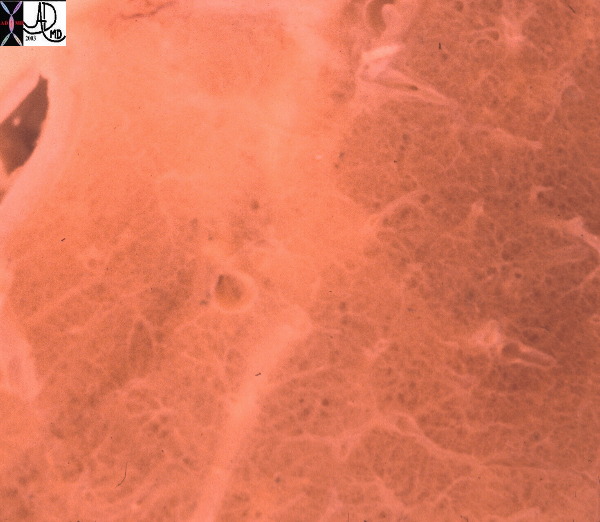 Sponge like nature Sponge like nature |
| This post mortem specimen of normal lung gives a sense of its sponge-like appearance. To the touch it also feels like a sponge.
Courtesy Ashley Davidoff MD 32300d |
ELASTIC NATURE
The chest wall and lungs are also characterized by their ability to elastically recoil after inspiration. The act of expiration is thus a passive process requiring no energy as the elastic recoil brings the lung back to unexpanded state.
COLOR
The color of the healthy lungs is affected by age and geographic location. In the young, they are pink and healthy appearing. In an industrial society the lungs are directly exposed to a smoky environment, and carbon particles are retained in the lungs and lymph nodes giving the lungs a dark slate gray color with a mottled appearance. With advancing age, the slate gray mottling changes to a black. The carbon-type granules are mostly deposited in the tissue near the surface of the lung.
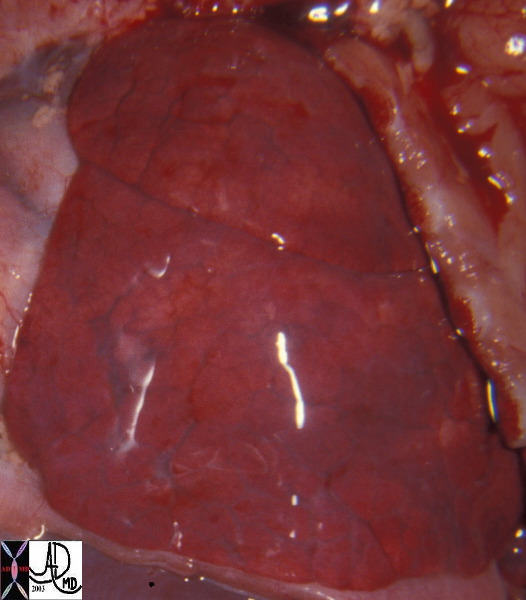 The lung of a baby The lung of a baby |
| This is the normal appearance of a young lung at autopsy, characterized by a pink color with glistening visceral pleura, probably taken from a relatively posterior angle and demonstrating the major fissure. The interlobular septa are slightly prominent outlining the secondary lobules. 32556c
Courtesy Ashley Davidoff MD |
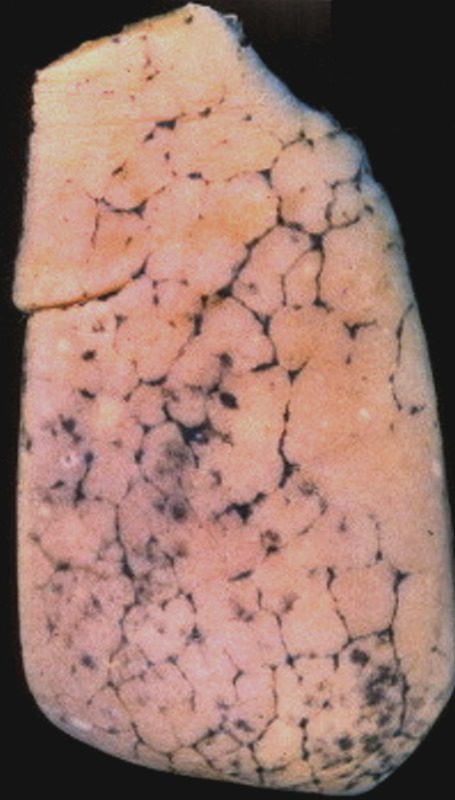
Anthracosis – Note the accumulation of carbon particles within the lymphatics along the interlobular septa, outlining the secondary lobules. The carbon particles are inhaled from an anthracotic urban environment. Courtesy Ashley Davidoff MD. 32291 code lung interlobular septum septa secondary lobule pulmonary lobule intertstitium interstitial grosspathology carbon
Applied Anatomy – Density
Density of the lung is measured in g/mL or if measured by CT in Hounsfield units (HU.) The density of the lung relates to the ratio of air to soft tissue. Thus during inspiration there will be an overall increase in the volume of air in the lung and thus an overall decrease in density. This translates into a measured density of 0.30 g/mL at functional residual capacity (FRC) to 0.14 g/mL at total lung capacity – more than 50% decrease in the overall density with a deep inspiration.
In addition there is a density gradient from hilum to periphery, and between upper and lower parts of the lung. In fact positional differences in density (and distribution of air) and parts of the lung between the supine, prone and upright situation, play an important role in pulmonary health of the bedridden.
Upstream in the hila (or medulla of the lung) the solid components of the conduit structures are more prominent, and the volume of alveoli is relatively diminished, whereas in the outer cortex the air filled alveoli dominate. In fact the outer 1/3 of the lung, houses 50% of the alveoli. This translates into a density difference between the innermost medulla and outermost cortex of about 10 fold. Near the hilum therefore, the measured density is 1 g/mL and peripherally it is 0.1 g/mL.
There is also difference in density from top to bottom. The blood flow distribution plays an important difference in this situation. All the pulmonary vessels are more distended in the lower lung fields. This is a well known observation of the radiologists on a CXR. In fact if the vessels to the upper lobes start looking either equal to or larger than the lower vessels it is a sign of cardiac failure.
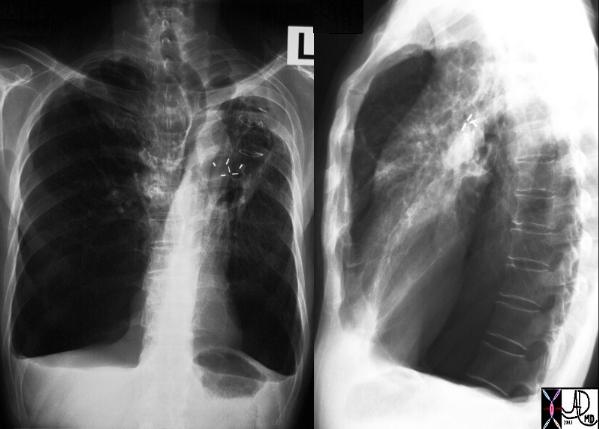 Emphysema Emphysema |
| The PA and lateral CXR reflects a patient with hyperinflated lung volumes, caused by COPD, and emphysema. There has been surgical removal of a lung carcinoma from the LUL. It is difficult to count posterior ribs, but the lungs definitely extend beyond the tenth. There is no doubt about the flattening of the hemidiaphragm both in the PA and lateral projections. In addition the lungs are so big that they have pushed the sternum forward. This results in a “barrel chest”, or a pigeon chest also known as a pectus carinatum. Courtesy Ashley Davidoff MD 30672c |
 Pneumothorax Pneumothorax |
| 47623c01.800 chest lung pleura pneumothorax character CTscan Davidoff MD |
 Pneumothorax Treated with Chest Tube Pneumothorax Treated with Chest Tube |
| 47624c02 chest lung pleura pneumothorax character dx pneumothorax s/p chest tube and treatment CXR plain film Davidoff MD |
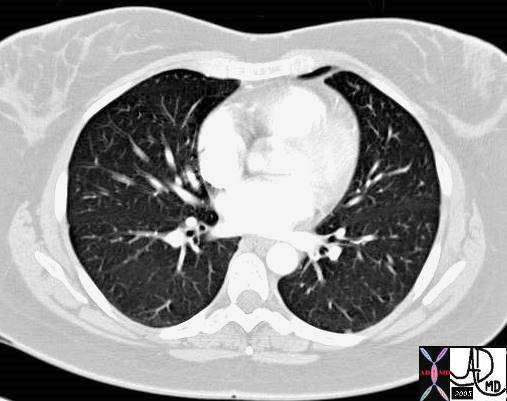 Normal lung Normal lung |
| This supine projection through the chest shows the vessels dominating in medial aspects of the lungs while peripherally the airways dominate. Density differences between the anterior middle and posterior aspects are not appreciated easily.
Courtesy Ashley Davidoff MD. 42511 |
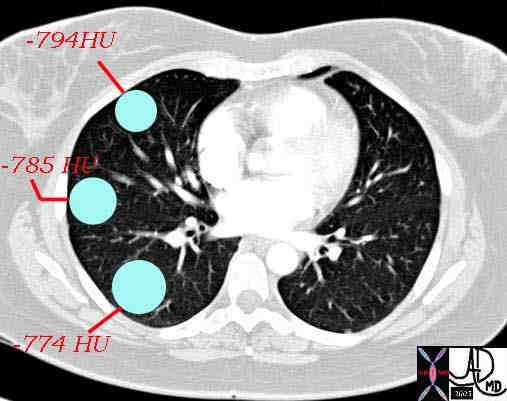 Normal lung Normal lung |
| When a cursor is placed on the anterior middle and posterior aspects of the lung the subtle differences are shown. These densities as measured are slightly higher than the average density for lung usually stated as about -850 HU. Note the lowest density (biggest negative) is anterior, and the lower densities are posterior. A patient lying supine restricts posterior lung movement and therefore less air goes posteriorly and relatively more air anteriorly. As a result in this patient the density anteriorly is 20 HU lower than the posterior density.
Courtesy Ashley Davidoff MD. 42511b02 |
Upstream in the hilar region (or medulla of the lung) we have noted that the solid components of the conduit structures are more prominent, and the volume of alveoli is relatively diminished, whereas in the outer cortex the air filled alveoli dominate. This translates into a density difference between the innermost medulla and outermost cortex of about 10 fold. Near the hilum therefore, the measured density is 1 g/mL and peripherally it is 0.1 g/mL.
There is also difference in density between the apical parts and the basal parts of the lungs. Blood flow distribution plays an important difference in this situation. All the pulmonary vessels are more distended in the lower lung fields and the higher ratio of blood vessels will result in a relatively higher density. The dominance of blood flow to the bases on a normal CXR is a well-known observation. In fact if the vessels to the upper lobes start looking either equal to or larger than the lower vessels it is a sign of early cardiac failure. This of course will translate to increasing densities in the upper lung fields.
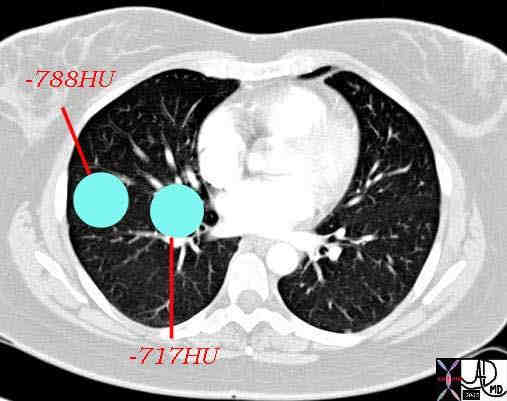
| Normal lung |
| When a cursor is placed on the lateral and medial aspects of the lung the differences which are obvious to the naked eye are documented by a difference of about 70 HU. This difference results from the dominance of vessels in the hilum and a relative paucity in the periphery where the alveoli dominate.
Courtesy Ashley Davidoff MD. 42511 |
In patients with emphysema and acute asthma the air is trapped in the alveoli and thus the lungs will be less dense. Lung density in the -950 range will be seen, with the actual density depending on the severity of the disease. The more severe the disease process the more air in the lungs and thus the less dense the lungs will be.
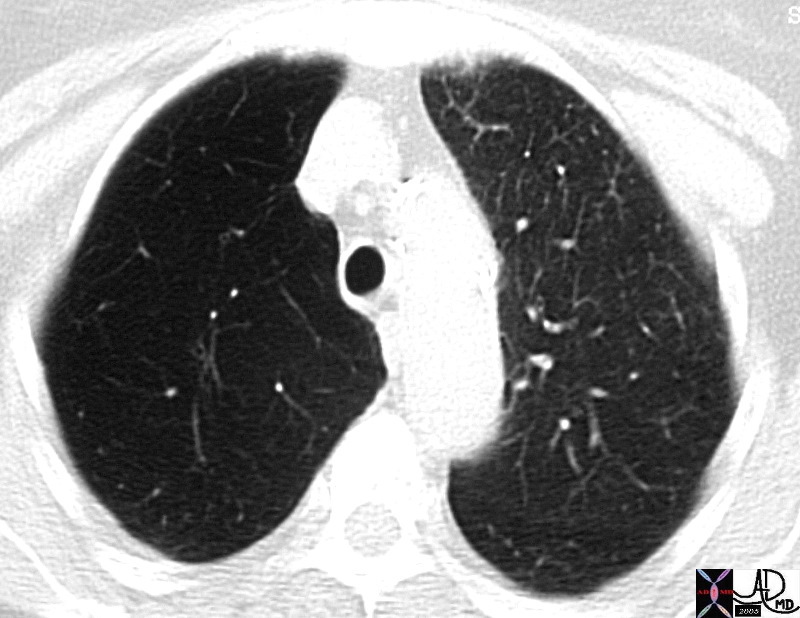
| Unilateral emphysema |
| In this image of a transverse section of the chest the right upper lobe is noted to be less dense than the LUL. The increased air in the RUL was caused by a mucous plug in a bronchus that acted as a ball-valve allowing air into the right lung but obstructing airflow out. Ths resulted in and unilateral emphysema. Courtesy Ashley Davidoff MD 32010b01 |

Air Trapping Due to Small airway Disease and Obstruction |
| In this patient the lower lobes and particulalrly the LLL is affected by air trapping probably related to bronchioler disease rwith esulting ball valve effect. In this entity, air can enter and cannot leave the alveoli and hence there is progressive in flation of the affected segments. The entity called Swyer James effect , is a disease usually of the RML whih has bronchiolar stenosis with ball valve effect caused by childhood infection.
47057c01 CTscan Davidoff MD |
The distinction between normal lung and emphysematous lung can be defined by measurement of the density boundaries of the lung as defined by Hounsfield units. When there is significant distribution of these densities emphysematous regions can be identified, color coded, and quantified.
This 73 –year-old female was a heavy smoker. Part of the left lung has been resected. In the coronal reformatted images the emphysematous lung is colored in red nd in the transverse section the emphysema is colored in blue. Quantitative analysis shows that more than 10% of the lung was involved in emphysema. Courtesy of: South Pointe Hospital and Philips Medical Systems
Changes in Density with Disease
Pneumonia in various forms is the most common lung disorder. The alveoli are filled with fluid blood and/or pus and the lungs start to look and feel like solid organs. In fact gross pathological descriptions of the lungs in various phases of lobar pneumonia are described with adjectives comparing them to the solid nature of the liver. The early hemorrhagic phase of lobar pneumonia is called “red hepatization”, and the later fibrinous phase is described as “gray hepatization”.
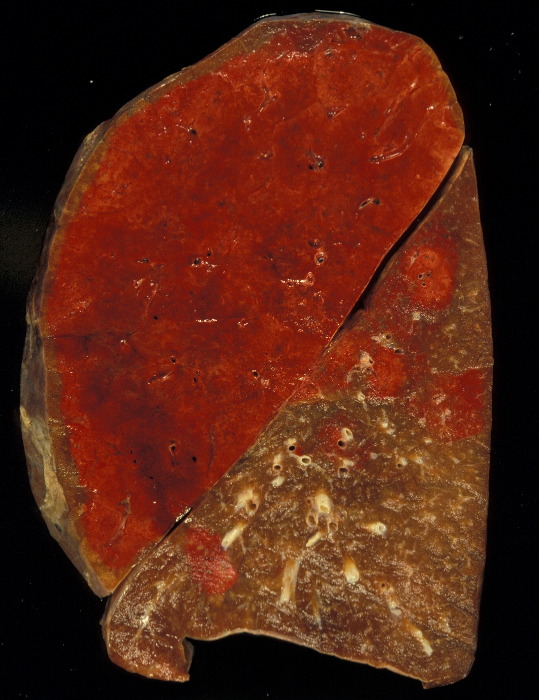
| Hemorrhagic pneumonia |
| This post mortem specimen of the left lung shows red hepatization caused by a hemorrhagic pneumonia of the LUL. Smaller areas of hemorrhagic consolidation are noted in the superior segment of the LUL and an anterior basal subsegment. This image also reflects the amterior position of the LUL and the posterior position of the LLL. Courtesy Ashley Davidoff MD. 32320 |
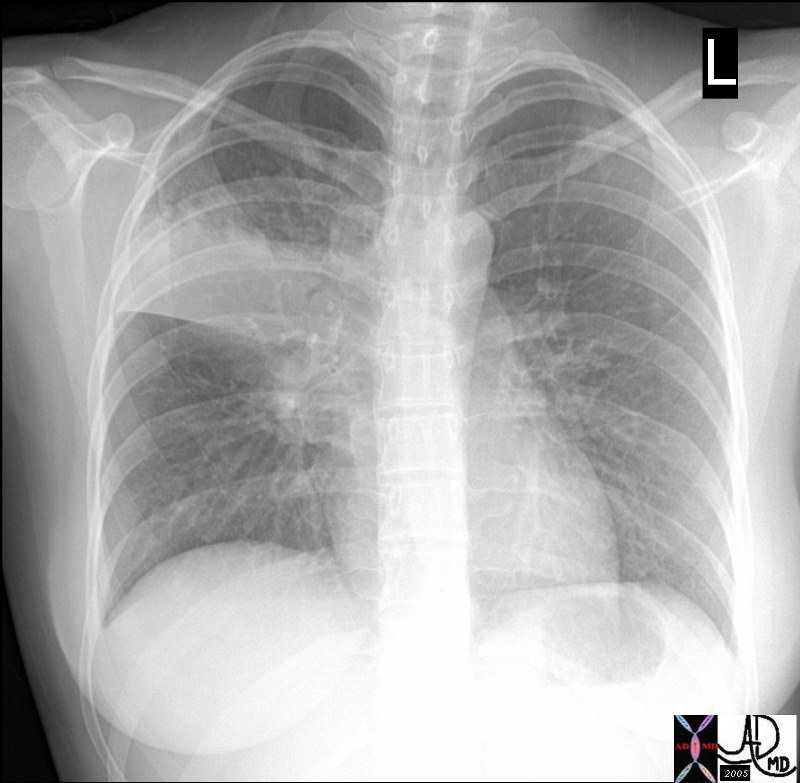
| Consolidation – pneumonia |
| This P-A CXR in a young female with a cough and fever shows a consolidation in the RUL caused by pneumonia. The air of the alveoli has been replaced with the water/soft tissue density of the pneumonia. Courtesy Ashley Davidoff MD 41798 |
Another common condition is congestive cardiac failure. In this instance the lungs become heavy and wet. The basal regions of the lower lobes are more affected because hydrostatic pressure is greater in these sites. In contrast long standing pulmonary congestion, particularly well known in chronic mitral stenosis, there may be leakage of red cells into the interstitium producing hardening by fibrosis and brown discoloration of the interstitium and the lungs. The following interstitial pattern in the lungs represents an interstitial infection.

| PCP pneumonia |
| The CXR shows classical hilar distribution of the reticular interstitial process of PCP pneumonia. In this case the density increases in linear fashion Courtesy of: Priscilla Slanetz, MD 30662 |
